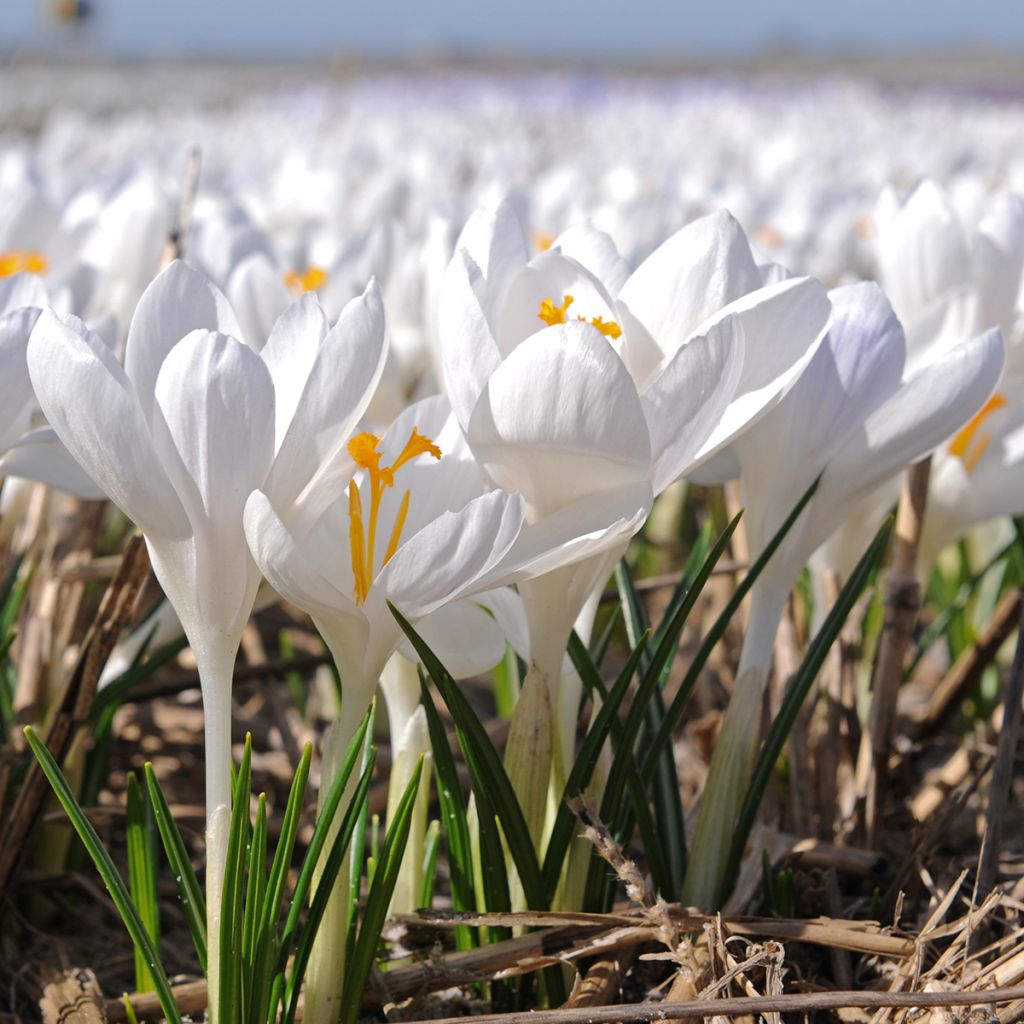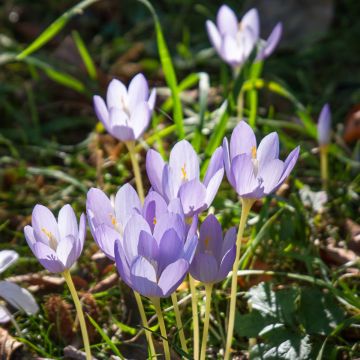

Crocus tommasinianus Ivory Princess - Early Crocus
Crocus tommasinianus Ivory Princess - Early Crocus
Crocus tommasinianus Ivory Princess
Early Crocus, Woodland Crocus, Tommasini's Crocus
Special offer!
Receive a €20 voucher for any order over €90 (excluding delivery costs, credit notes, and plastic-free options)!
1- Add your favorite plants to your cart.
2- Once you have reached €90, confirm your order (you can even choose the delivery date!).
3- As soon as your order is shipped, you will receive an email containing your voucher code, valid for 3 months (90 days).
Your voucher is unique and can only be used once, for any order with a minimum value of €20, excluding delivery costs.
Can be combined with other current offers, non-divisible and non-refundable.
This plant carries a 6 months recovery warranty
More information
We guarantee the quality of our plants for a full growing cycle, and will replace at our expense any plant that fails to recover under normal climatic and planting conditions.
Would this plant suit my garden?
Set up your Plantfit profile →
Description
Crocus tommasinianus 'Ivory Princess' is a superb horticultural variety of a botanical crocus native to central Europe. Early-flowering, it offers magnificent pure white blooms in March that illuminates the spaces where it develops in large patches. It naturalises easily and presents no cultivation difficulties, tolerating many types of soils. It can also be easily grown in pots or containers to enhance patios and balconies.
Crocus tommasinianus, also known as the early crocus, belongs to the large Iridaceae family, which includes nearly 1700 species and well-known genera such as gladioli, iris, freesias, and crocosmias. This crocus is native to central Europe (Hungary, Croatia, Serbia, Bulgaria, etc.). It quickly forms large colonies in upright tufts of 10 to 15cm (4 to 6in) in height. Flowering takes place from February to March, depending on the regions.
'Ivory Princess' is a horticultural variety whose flowering rises 8 or 10cm (3 or 4in) above the ground. Forming a narrow tube at the base, the 6 tepals (petals and sepals of the same morphology) open at the top into a pure white cup. In the centre of the corolla, the stigmas (female parts) and the stamens (male parts) display the same yellow hue, which is particularly decorative in this white ensemble. The flowers close at night and in bad weather, then open widely in the sun and even in partial shade. The foliage consists of narrow, thick linear leaves, which are single and alternate. They display a shiny dark green colour, with a white-silvery central stripe. It dries out a few weeks after flowering, while the plant goes into dormancy to escape hot weather. Crocuses are classified as bulbous plants, but they actually arise from a corm. A corm is, in plant morphology, an underground storage organ that looks like a bulb but is made up of a swollen stem surrounded by scales.
Particularly adaptable, this crocus tolerates heavy soils better than other bulbous plants and naturalises very easily.
Crocus tommasinianus 'Ivory Princess' is ideal for novice gardeners, as it is one of the easiest to grow successfully. It can be used in rockeries, alongside dwarf plants like Picea abies 'Little Gem', a spruce that forms a small round and compact cushion. It can also highlight the edges of a sinuous path, in the company of irises that will bloom later in spring, creating a lasting floral scene. At the edge of trees, you can associate them with Cyclamen coum rose, which blooms at the same time and offers a beautiful spectacle. If you prefer blue blooms, Scilla siberica 'Spring Beauty' will enchant you with its small bells. In a lawn, this crocus will blend well with Eranthis hyemalis, or winter aconite, a small tuberous perennial with early yellow flowering.
Report an error about the product description
Plant habit
Flowering
Foliage
Safety measures
Botanical data
Crocus
tommasinianus
Ivory Princess
Iridaceae
Early Crocus, Woodland Crocus, Tommasini's Crocus
Central Europe
ingestion
Cette plante est toxique si elle est ingérée volontairement ou involontairement.
Ne la plantez pas là où de jeunes enfants peuvent évoluer, et lavez-vous les mains après l'avoir manipulée.
Pensez à conserver l'étiquette de la plante, à la photographier ou à noter son nom, afin de faciliter le travail des professionnels de santé.
Davantage d'informations sur https://plantes-risque.info
Other Spring Crocus
View all →Planting and care
Plant from September to December, in light soil, at a depth of 8cm (3in) and spacing of 5cm (2in). Alternatively, plant in groups of three every 15 to 20cm (6 to 8in). It is preferable to leave them in place. They will form increasingly floriferous clumps. Also consider making a few pots for your patio. It is tolerant of soil, and will accept lightly acidic, neutral, or alkaline ones. It is relatively tolerant of (non-stagnant) moisture. It prefers a sunny exposure that allows for full opening of the corollas. It is also important to place it sheltered from cold winds, even though it can withstand temperatures as low as -23°C (-9.4°F). Its natural habitat is in open areas. The plants have the best effect when planted in groups of 5 to 10 specimens. Once acclimatised and established, they multiply quickly. It does not require any particular maintenance. It is important not to cut the foliage before it turns yellow. The corms are susceptible to excess moisture, which can cause them to rot during their resting period. Rodents are fond of these corms, and snails and slugs feed on all aerial parts of the plant.
Planting period
Intended location
Care
This item has not been reviewed yet - be the first to leave a review about it.
Haven't found what you were looking for?
Hardiness is the lowest winter temperature a plant can endure without suffering serious damage or even dying. However, hardiness is affected by location (a sheltered area, such as a patio), protection (winter cover) and soil type (hardiness is improved by well-drained soil).

Photo Sharing Terms & Conditions
In order to encourage gardeners to interact and share their experiences, Promesse de fleurs offers various media enabling content to be uploaded onto its Site - in particular via the ‘Photo sharing’ module.
The User agrees to refrain from:
- Posting any content that is illegal, prejudicial, insulting, racist, inciteful to hatred, revisionist, contrary to public decency, that infringes on privacy or on the privacy rights of third parties, in particular the publicity rights of persons and goods, intellectual property rights, or the right to privacy.
- Submitting content on behalf of a third party;
- Impersonate the identity of a third party and/or publish any personal information about a third party;
In general, the User undertakes to refrain from any unethical behaviour.
All Content (in particular text, comments, files, images, photos, videos, creative works, etc.), which may be subject to property or intellectual property rights, image or other private rights, shall remain the property of the User, subject to the limited rights granted by the terms of the licence granted by Promesse de fleurs as stated below. Users are at liberty to publish or not to publish such Content on the Site, notably via the ‘Photo Sharing’ facility, and accept that this Content shall be made public and freely accessible, notably on the Internet.
Users further acknowledge, undertake to have ,and guarantee that they hold all necessary rights and permissions to publish such material on the Site, in particular with regard to the legislation in force pertaining to any privacy, property, intellectual property, image, or contractual rights, or rights of any other nature. By publishing such Content on the Site, Users acknowledge accepting full liability as publishers of the Content within the meaning of the law, and grant Promesse de fleurs, free of charge, an inclusive, worldwide licence for the said Content for the entire duration of its publication, including all reproduction, representation, up/downloading, displaying, performing, transmission, and storage rights.
Users also grant permission for their name to be linked to the Content and accept that this link may not always be made available.
By engaging in posting material, Users consent to their Content becoming automatically accessible on the Internet, in particular on other sites and/or blogs and/or web pages of the Promesse de fleurs site, including in particular social pages and the Promesse de fleurs catalogue.
Users may secure the removal of entrusted content free of charge by issuing a simple request via our contact form.
The flowering period indicated on our website applies to countries and regions located in USDA zone 8 (France, the United Kingdom, Ireland, the Netherlands, etc.)
It will vary according to where you live:
- In zones 9 to 10 (Italy, Spain, Greece, etc.), flowering will occur about 2 to 4 weeks earlier.
- In zones 6 to 7 (Germany, Poland, Slovenia, and lower mountainous regions), flowering will be delayed by 2 to 3 weeks.
- In zone 5 (Central Europe, Scandinavia), blooming will be delayed by 3 to 5 weeks.
In temperate climates, pruning of spring-flowering shrubs (forsythia, spireas, etc.) should be done just after flowering.
Pruning of summer-flowering shrubs (Indian Lilac, Perovskia, etc.) can be done in winter or spring.
In cold regions as well as with frost-sensitive plants, avoid pruning too early when severe frosts may still occur.
The planting period indicated on our website applies to countries and regions located in USDA zone 8 (France, United Kingdom, Ireland, Netherlands).
It will vary according to where you live:
- In Mediterranean zones (Marseille, Madrid, Milan, etc.), autumn and winter are the best planting periods.
- In continental zones (Strasbourg, Munich, Vienna, etc.), delay planting by 2 to 3 weeks in spring and bring it forward by 2 to 4 weeks in autumn.
- In mountainous regions (the Alps, Pyrenees, Carpathians, etc.), it is best to plant in late spring (May-June) or late summer (August-September).
The harvesting period indicated on our website applies to countries and regions in USDA zone 8 (France, England, Ireland, the Netherlands).
In colder areas (Scandinavia, Poland, Austria...) fruit and vegetable harvests are likely to be delayed by 3-4 weeks.
In warmer areas (Italy, Spain, Greece, etc.), harvesting will probably take place earlier, depending on weather conditions.
The sowing periods indicated on our website apply to countries and regions within USDA Zone 8 (France, UK, Ireland, Netherlands).
In colder areas (Scandinavia, Poland, Austria...), delay any outdoor sowing by 3-4 weeks, or sow under glass.
In warmer climes (Italy, Spain, Greece, etc.), bring outdoor sowing forward by a few weeks.

































